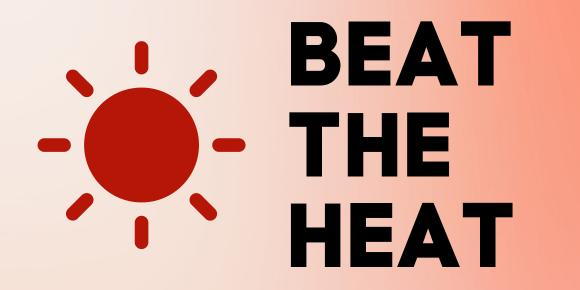
This past weekend I was up in Norwalk watching my nephew’s baseball tournament (GO BALLARD!!!), and during the 3rd game of the day, one of the Umps succumbed to a heat injury. NOT COOL (for him or the tournament). Also, proper intervention at the onset could have improved his outcomes.
Just like in many sports, sometimes the best offense we can have begins with a stellar defense. Preparing to stay in the game during these summer months begins with prevention.
Here’s what we are going to cover:
- Prevention of heat injuries
- Risk factors
- Heat cramps
- Heat exhaustion
- Heat stroke
- And treatment for these injuries.
Let’s chat prevention first. The single most crucial factor in reducing heat injuries is appropriate hydration. Cooler temperature fluids are absorbed more quickly too, so temperature of what you are consuming can make a difference too.
Weight charts. This is a more advance measure of ensuring appropriate hydration in your athletes, BUT understanding your baseline hydration and maintenance of that can make all the difference when beating the summer heat. Team providers or coaches that are able to help you track the loss of body weight can help determine how much hydration is necessary. 3-5% loss of body weight (or 2-5 lbs. over 24 hours) can identify a risk of heat injuries. This will take some time to figure out, but once you have a good idea of how much and what you should consume, it gets easier.
Guidelines for hydration:
Day before competition: ¼ oz of water per lb. of bodyweight throughout the day
4 hours before competition: if dehydration is a problem, 1 oz sport drink per 10lbs body weight (or consider electrolyte replacement alternative)
3 hours prior: 1 oz sport drink per 10lbs body weight (or consider electrolyte replacement alternative)
2 hours prior: 1 oz sport drink per 10lbs body weight (or consider electrolyte replacement alternative)
1 hour prior: 1 oz sport drink per 10lbs body weight (or consider electrolyte replacement alternative)
During competition: drink as much as comfortably possible without impeding performance
Recovery: 16 oz per lb of body weight lost.
The second most helpful tip for prevention is acclimatization. Repeated and graded exposure to warm periods allows athletes to progressively adapt to physical activity in hot environments.
Risk factors for heat injuries include: obese athletes, athletes with a recent fever, dehydrated athletes, alcohol consumption, heavy equipment (i.e.: catcher’s gear), and prior heat injuries.
Let’s move on to some of the most common heat related disorders I see and their treatment.
- Heat Cramps. This is by far the most common heat injury I see. It’s pretty self explanatory, usually cramping in the calf, thigh or abdominal musculature. Heavy sweating with loss of Na+ and replacement with low sodium concentrate water is usually the culprit.
Here’s what to do when you have an athlete with this:
-Cease activities
-Move athlete to a cooler place
-Give cool drinks with Na+ and cool the athlete (fans and ice are great).
-Stretching and light range of motion
-Rest
-IV therapy may be supplemented if symptoms do not improve
- Heat Exhaustion. This is a form of shock that is caused by higher core body temperature exertion in hot water with resulting water depletion. This is why weight charts are so important to identify weight loss secondary to fluid loss.
Some symptoms may include: sweating, dizziness, exhaustion, elevated temperature, headache, weakness, decreased urinary output, altered mental state (possible, not normal, but no CNS dysfunction), muscle cramps, tachycardia, orthostatic hypotension, muscle aches, nausea or vomiting, diarrhea, elevated core temp (less than 104F)
Treatment includes:
-Same as for heat cramps and move to cooler environment
-Cool athlete down with fans and ice and remove excess clothing
-Fluids (oral or IV may be necessary)
-Monitor for shock
- Heat Stroke. This is a true medical emergency. Heat strokes have a high mortality and high morbidity rates. It is the 2nd leading cause of fatalities in football (head injuries being #1). The body produces heat at a higher level through muscle activation. There are 2 different kinds of heat stroke—classic and exertional
These athletes may have:
-Hyperthermia with a core temp over 104 (rectal is best practice)
-Signs and symptoms of CNS disorder (ataxic gait, cognitive dysfunction, etc.)
-Classic heat stroke victims often cease sweating , while exertional heat stroke victims are almost always still sweating.
-Hypotension
-Vomiting and/or nausea
-Seizures
-Altered mental status
Treatment includes:
-Rapid and immediate cooling (goal of 102F)
-Implement EMS
-IV fluids
-Monitor vitals every 5-10 min.
If you are unsure whether your athlete has entered into heat stroke or you are uncomfortable with their symptoms and managing, get them to a higher level of care immediately. Error on the side of caution. Heat injuries are no joke and can be life threatening, but knowing how to manage them, but most importantly prevent them, will serve you and your athletes well to BEAT THE HEAT!
